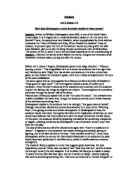How Does Shakespeare Create Differing Moods In These Scenes Through The Language The Characters Use?
Act IIi and Act Viii
In the beginning of Act IIii it is dark and night has settled in. The scene opens with some casual conversation, which tells us that it's very dark, and that something bad is about to happen. Macbeth enters with a servant and has an awkward conversation with Banquo. This is signified by the conversation about Duncan. Macbeth wishes for Banquo’s presence in the killing and the betrayal of Duncan. The fact that it is night sends a sense of creepiness. It gives the sense that there is going to be a murder due to the awkwardness of the conversation. With the night and moon lurking about it gives a sense of evil. It is the time when evil deeds shall be thought of, discussed of, or carried out. It heightens the mood darkness and how evil will take over the night. Macbeth’s short and quick sentences shows his uneasiness and gives a sort of dark and disturbing mood. When Banquo says,” Who’s there?” it shoes that Banquo is afraid and edgy because he shouldn’t have anything to fear because he is within the castle’s locked gates but he still is frightened. This heightens the spookiness and the darkness in the scene.







